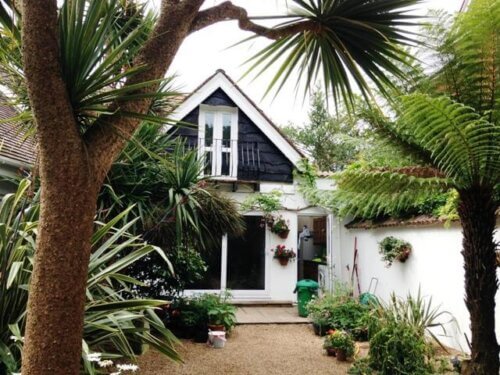1) Choosing Colours
Match the style of your neighbourhood (especially if in terraced/semi-detached). Consider how natural light changes colours during the day. Light tones brighten shaded homes, while darker colours can ground large façades.
2) Calculating Paint
Measure wall area (length × height), then subtract windows/doors. Factor in that rough masonry, pebble dash, or textured render will need 15–25% more paint than smooth brickwork.
3) Picking Paint Types
Masonry walls: smooth or textured masonry paint.
Wood & metal: exterior-grade gloss/satin.
Bare wood: use microporous paint to let moisture escape and prevent rot.
Coastal areas: consider marine-grade paints for extra protection from salt air.
4) Preparing Surfaces
Scrape off flaking paint, sand rough edges, and clean with a stiff brush. Treat mould, moss, or algae with a fungicidal wash (available from UK DIY stores). Fill cracks with exterior filler and allow to dry fully before painting.
5) Protecting Adjacent Areas
Cover paths, windows, and plants with dust sheets or polythene. Mask around trims and fittings. Remove or cover house numbers, lights, and satellite dishes where possible.
6) Checking Weather Conditions
In the UK, aim for at least 2–3 dry days in a row. Avoid painting in direct strong sunlight (can cause blistering) or when temperatures are below 10°C. Always check the 5-day forecast.
7) Choosing the Right Tools
Rollers with long pile for rough render or pebble dash.
Smooth rollers for flat masonry.
Brushes with synthetic bristles for water-based paints.
Extension poles to reduce ladder use.
8) Safety First
Follow ladder safety: stable base, 4:1 angle, and three points of contact. For houses above two storeys, consider scaffolding for safe, efficient work.
9) Allow for Drying Time
Most UK exterior paints need 4–6 hours between coats. Always check manufacturer guidance. Avoid evening painting in damp conditions as dew can spoil the finish.
10) Plan for Disposal & Clean-up
Never pour leftover paint or wash water down drains. Use your local council’s paint disposal scheme (most UK councils provide this). Store sealed tins indoors for future touch-ups.




